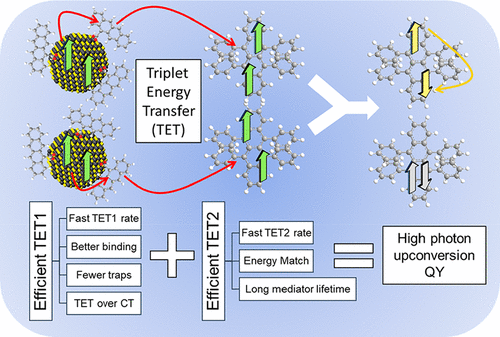当前位置:
X-MOL 学术
›
Acc. Chem. Res.
›
论文详情
Our official English website, www.x-mol.net, welcomes your
feedback! (Note: you will need to create a separate account there.)
Mechanistic Understanding and Rational Design of Quantum Dot/Mediator Interfaces for Efficient Photon Upconversion
Accounts of Chemical Research ( IF 16.4 ) Pub Date : 2020-11-03 , DOI: 10.1021/acs.accounts.0c00526 Zihao Xu 1 , Zhiyuan Huang 2 , Tao Jin 1 , Tianquan Lian 1 , Ming L. Tang 2
Accounts of Chemical Research ( IF 16.4 ) Pub Date : 2020-11-03 , DOI: 10.1021/acs.accounts.0c00526 Zihao Xu 1 , Zhiyuan Huang 2 , Tao Jin 1 , Tianquan Lian 1 , Ming L. Tang 2
Affiliation

|
The semiconductor-nanocrystal-sensitized, three-component upconversion system has made great strides over the past 5 years. The three components (i.e., triplet photosensitizer, mediator, and emitter) each play critical roles in determining the input and output photon energy and overall quantum efficiency (QE). The nanocrystal photosensitizer converts the absorbed photon into singlet excitons and then triplet excitons via intersystem crossing. The mediator accepts the triplet exciton via either direct Dexter-type triplet energy transfer (TET) or sequential charge transfer (CT) while extending the exciton lifetime. Through a second triplet energy-transfer step from the mediator to the emitter, the latter is populated in its lowest excited triplet state. Triplet–triplet annihilation (TTA) between two triplet emitters generates the emitter in its bright singlet state, which then emits the upconverted photon. Quantum dots (QD) have a tunable band gap, large extinction coefficient, and small singlet–triplet energy losses compared to metal–ligand charge-transfer complexes. This high triplet exciton yield makes QDs good candidates for photosensitizers. In terms of driving triplet energy transfer, the triplet energy of the mediator should be slightly lower than the triplet exciton energy of the QD sensitizer for a downhill energy landscape with minimal energy loss. The same energy cascade is also required for the transfer from the mediator to the emitter. Finally, the triplet energy of the emitter must be slightly larger than one-half of its singlet energy to ensure that TTA is exothermic. Optimization of the sensitizer, mediator, and emitter will lead to an increase in the anti-Stokes shift and the total quantum efficiency. Evaluating each individual step’s efficiency and kinetics is necessary for the understanding of the limiting factors in existing systems.
中文翻译:

高效光子上转换的量子点/介体界面的机理理解和合理设计
在过去的5年中,半导体纳米晶体敏化的三组分上转换系统取得了长足的进步。这三个组件(即三重态光敏剂,介体和发射体)在确定输入和输出光子能量以及总体量子效率(QE)方面均起着至关重要的作用。纳米晶体光敏剂通过系统间交叉将吸收的光子转换为单重态激子,然后转化为三重态激子。介体通过直接德克斯特型三重态能量转移(TET)或顺序电荷转移(CT)接受三重态激子,同时延长了激子寿命。通过从介体到发射极的第二个三重态能量转移步骤,后者以最低的激发三重态处于填充状态。两个三重态发射器之间的三重态-三重态an灭(TTA)产生处于明亮单重态的发射器,然后发射上转换的光子。与金属-配体电荷转移复合物相比,量子点(QD)具有可调的带隙,大的消光系数和小的单重态-三重态能量损失。这种高三重态激子产率使量子点成为光敏剂的理想候选者。在驱动三重态能量转移方面,对于下坡的能量格局,能量损失最小,介体的三重态能量应略低于QD敏化剂的三重态激子能量。从介体到发射极的转移也需要相同的能量级联。最后,发射器的三重态能量必须略大于其单重态能量的一半,以确保TTA放热。敏化剂,介体和发射体的优化将导致反斯托克斯位移和总量子效率的提高。评估每个步骤的效率和动力学对于理解现有系统中的限制因素是必要的。
更新日期:2021-01-05
中文翻译:

高效光子上转换的量子点/介体界面的机理理解和合理设计
在过去的5年中,半导体纳米晶体敏化的三组分上转换系统取得了长足的进步。这三个组件(即三重态光敏剂,介体和发射体)在确定输入和输出光子能量以及总体量子效率(QE)方面均起着至关重要的作用。纳米晶体光敏剂通过系统间交叉将吸收的光子转换为单重态激子,然后转化为三重态激子。介体通过直接德克斯特型三重态能量转移(TET)或顺序电荷转移(CT)接受三重态激子,同时延长了激子寿命。通过从介体到发射极的第二个三重态能量转移步骤,后者以最低的激发三重态处于填充状态。两个三重态发射器之间的三重态-三重态an灭(TTA)产生处于明亮单重态的发射器,然后发射上转换的光子。与金属-配体电荷转移复合物相比,量子点(QD)具有可调的带隙,大的消光系数和小的单重态-三重态能量损失。这种高三重态激子产率使量子点成为光敏剂的理想候选者。在驱动三重态能量转移方面,对于下坡的能量格局,能量损失最小,介体的三重态能量应略低于QD敏化剂的三重态激子能量。从介体到发射极的转移也需要相同的能量级联。最后,发射器的三重态能量必须略大于其单重态能量的一半,以确保TTA放热。敏化剂,介体和发射体的优化将导致反斯托克斯位移和总量子效率的提高。评估每个步骤的效率和动力学对于理解现有系统中的限制因素是必要的。











































 京公网安备 11010802027423号
京公网安备 11010802027423号